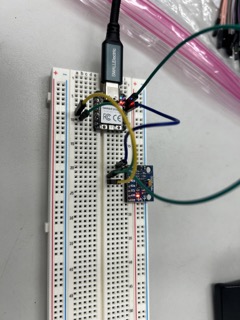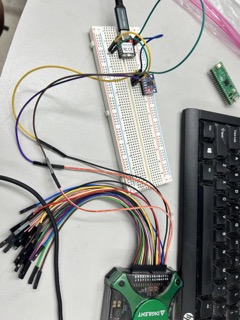Group Project¶
For the group project, we are supposed to probe an input device’s analog levels and digital signals. Unfortunately, I was not with the entire group when they tested the accelerometer with the Analog2Discovery. As a result, I will be testing the circuit again in order to confirm the first team’s results.
Mistake¶
I accidentally broke the board that I milled for the accelerometer, because the female pins that were vertically soldered onto the board weren’t very stable. So, I have to conduct the test using a breadboard.
Wiring¶
First, I wired the schematic of the accelerometer by itself with the RP2040 Xiao board to make sure that the program is working (as described in my individual part):

Then, I connected this part with an Analog2Discovery machine. I connected positive pin on Channel 1 to the SCL pin, and the negative pin on Channel 1 and the general negative pin to the ground.
The power pin on the Analog is not connected as the accelerometer is already being powered by the computer.
Here is the complete wiring:

Results¶
I didn’t have any trouble capturing the results of the data on Waveform. First, I booted up the Waveform software and went to the Scope tab. I didn’t need to set a voltage in the supplies tab because the accelerometer was already being powered by the Xiao.
Next, I clicked run, and changed the rate settings to 100MHz in order to display the graph more smoothly.
Here is the result for the SCL pin:
Here is the SDA pin:
In the videos, I have also included a frequency measurement. It looks like the SCL pin’s frequency hovers around 330000 Hz, which is close to the frequency in the Thonny code at 400,000 Hz.
You can also see that the peaks are not evenly distributed and flashes in and out of sight. This is due to the large amount of noise in the connection, as the I2C communication system is not very practical. This phenomenon could especially be seen in the SDA pin, since data is transmitted through this line. As a result, the data makes the frequency more volatile.
You can check out the rest of the group work here.